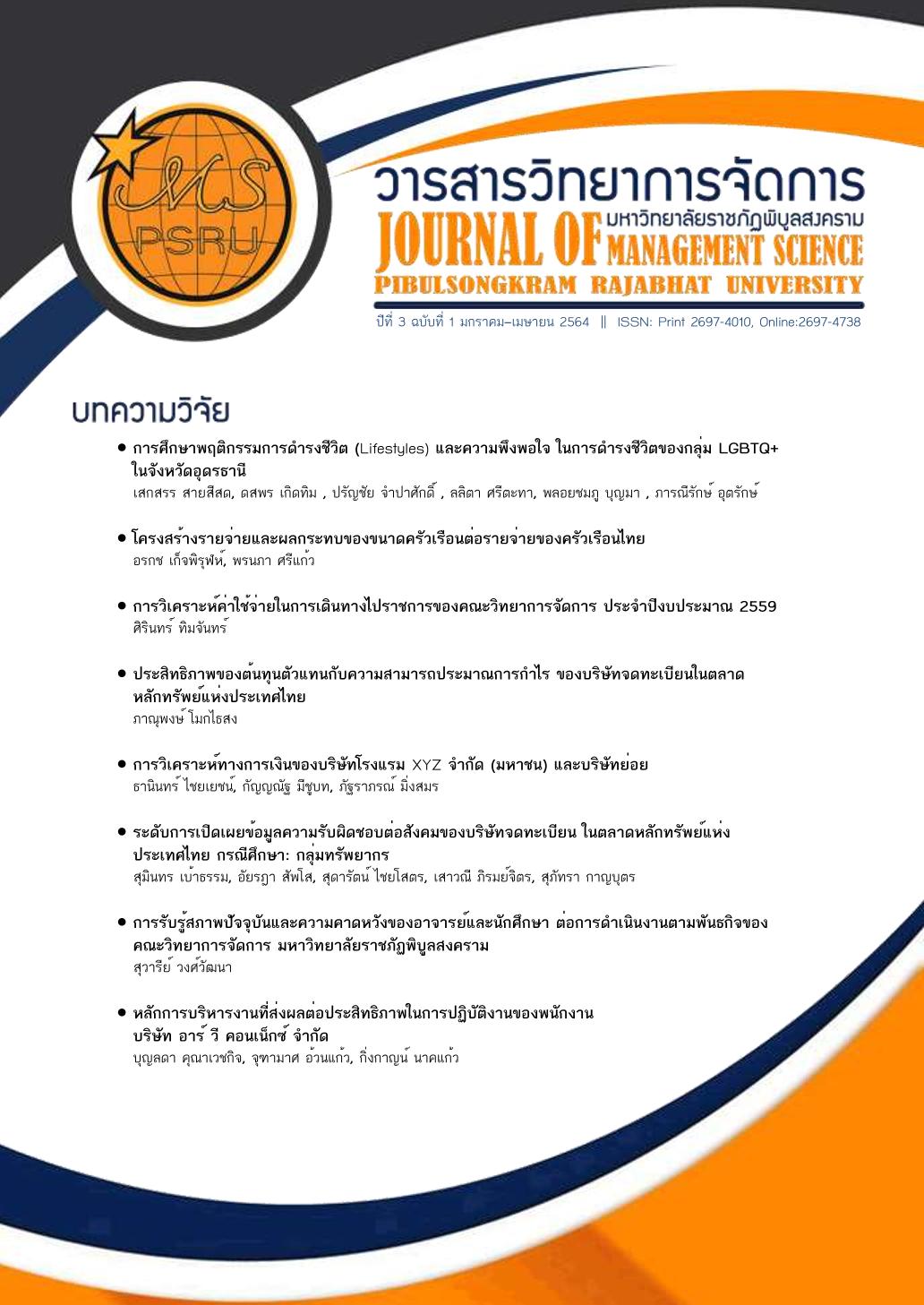Expenditure Structure and Effects of Household size on Thailand household expenditure.
Keywords:
Household expenditure, Household income, Household sizeAbstract
Economic, social and demographic structure in Thailand has changed, in the past several decades. Especially, transition from a large family to a small family, including, entering an aging society has affected the way of life and the standard of living of Thai population. The main objectives of this research paper are to compare the expenditure structure of different household size and analyze the effects of household size on household expenditure by secondary data obtained from Household Socio-Economic Survey 2019, National Statistical Office. Descriptive statistics and simple regression equation were employed in the analysis. The comparison results of household expenditure structure in different household sizes indicated that, on average, the majority of expenditure of every household size was on food, drink, and tobacco. For people who live alone, the second majority was housing expenses, as those who live more than one member; the second majority was travel and communication expenses. The results of the effect of household size on household expenditure found that income levels, and household size affect total household expenditure in the same direction which was statistically significant at 0.01 level.
References
ครัวเรือนไทย. (มปป.). สำมะโนประชากรและเคหะ: นานาสาระ ข้อมูลประชากร. สืบค้น 26 มิถุนายน 2564, จาก http://www.nso.go.th/sites/2014/Pages/pop/ครัวเรือนไทย.aspx
เจาะลึกระบบสุขภาพ. (2556, 27 เมษายน). ห่วงผู้สูงอายุไทยส่อขาดคนดูแลเหตุอัตราเกิดลด. กรุงเทพธุรกิจ. สืบค้น 4 มิถุนายน 2564, จาก https://www.hfocus.org/content/2013/04/2929
ณัฐมธุรา ภูริเทเวศร์. (2547). การวิเคราะห์ค่าใช้จ่ายของครัวเรือนในการบริโภคผลไม้ในเขตกรุงเทพมหานคร. (วิทยานิพนธ์ปริญญามหาบัณฑิต). กรุงเทพฯ: มหาวิทยาลัยเกษตรศาสตร์.
ธนาคารแห่งประเทศไทย. (2562). รายงานภาวะเศรษฐกิจไทย ปี 2562. สืบค้น 26 มิถุนายน 2564, จากhttps://www.bot.or.th/Thai/MonetaryPolicy/EconomicConditions/AnnualReport/AnnualReport/AanualReport2562.pdf
ภัทรพร กิจชัยนุกูล และพาชิตชนัญ ศิริพานิช. (2557). ปัจจัยที่มีอิทธิพลต่อค่าใช้จ่ายของประชาชนในกรุงเทพมหานคร. วารสารจันทรเกษมสาร, 20(38), 97-105.
เยาวลักษณ์ สมคำ. (2552). การวิเคราะห์โครงสร้างค่าใช้จ่ายของภาคครัวเรือนในประเทศไทย. (วิทยานิพนธ์ปริญญามหาบัณฑิต). กรุงเทพฯ: มหาวิทยาลัยธุรกิจบัณฑิตย์.
วาทิตร รักษ์ธรรม. (2548). การวิเคราะห์ภาคตัดขวางของพฤติกรรมและฟังก์ชันการบริโภคของครัวเรือนไทย. (วิทยานิพนธ์ปริญญามหาบัณฑิต). กรุงเทพฯ: มหาวิทยาลัยหอการค้าไทย. ISBN: 974-677-539-1.
สรวงมณฑ์ สิทธิสมาน. (2564, 14 กุมภาพันธ์). เด็กเกิดน้อย ต้องเพิ่มคุณภาพไม่ใช่ปริมาณ. ผู้จัดการออนไลน์.สืบค้น 15 มีนาคม 2564, จาก https://mgronline.com/qol/detail/9640000015703
สำนักงานสถิติแห่งชาติ. (2553). สำมะโนประชากรและเคหะ พ.ศ. 2553. สืบค้น 26 มิถุนายน 2564, จาก https://broadcast.nbtc.go.th/data/training/doc/570200000023.pdf
สำนักงานสถิติแห่งชาติ. (2543, 2553, 2563). รายงานผลการสำรวจข้อมูลพื้นฐานของครัวเรือน 2563 ทั่วราชอาณาจักร. สืบค้น 11 มีนาคม 2564, จาก http://www.nso.go.th/sites/2014/DocLib13/ด้านสังคม/สาขาประชากร/ข้อมูลพื้นฐานครัวเรือน/2563/full_ report.pdf
Banerjee, A. V., & Duflo, E. (2007). The Economic Lives of the Poor. The Journal of Economic Perspectives, 21(1), 141-167. doi: 10.1257/089533007780095556
Bils, M., & Klenow, P. J. (2001). Quantifying Quality Growth. The American Economic Review, 91(4), 1006-1030. doi: 10.1257/aer.91.4.1006
Carsten, S., Katrin, R., Daiju, N., & Toishihiro, O. (2015). The decline in average family size and its implications for the average benefits of within-household sharing, Oxford Economic papers, 67(3), 760-780.
Chai, A. (2018). Household consumption patterns and the sectorial composition of growing economies: A review of the interlinkages. Vienna: United Nations Industrial Development Organization.
Houthakker, H. S. (1957). An international comparison of household expenditure patterns. Econometrica, 25, 532-551.
Jackson, L. F. (1984). Hierarchic Demand and the Engel Curve for Variety. The Review of Economics and Statistics, 66(1), 8-15.
Jain, L. R. (1983). Effect of household size on household expenditure pattern: Application of an addilog Engel model. The Indian Journal of Statistics, 45(3), 431-446.
Keynes, J. M. (1936). The general theory of employment, interest, and money. New York: Harcourt, Brace, and Company.
Kim, K. S., & Kim, D. Y. (1975). The effect of household size, structure and income on expenditure patterns. Geneva: International Labor organization.
Kuznetz, S. (1946). National product since 1869. New York: National Bureau of Economics Research Inc.
Downloads
Published
How to Cite
Issue
Section
License
Copyright (c) 2021 Pibulsongkram Rajabhat University

This work is licensed under a Creative Commons Attribution-NonCommercial-NoDerivatives 4.0 International License.
บทความที่ได้รับการตีพิมพ์ในวารสารวิทยาการจัดการมหาวิทยาลัยราชภัฏพิบูลสงคราม เป็นลิขสิทธิ์ของมหาวิทยาลัยราชภัฎพิบูลสงคราม
บทความที่ลงพิมพ์ใน วารสารวิทยาการจัดการมหาวิทยาลัยราชภัฎพิบูลสงคราม ถือว่าเป็นความเห็นส่วนตัวของผู้เขียนคณะบรรณาธิการไม่จำเป็นต้องเห็นด้วย ผู้เขียนต้องรับผิดชอบต่อบทความของตนเอง


